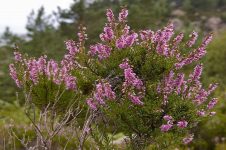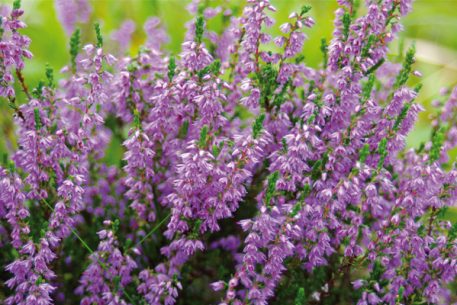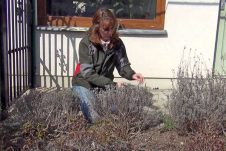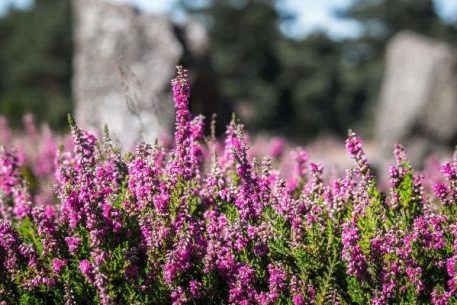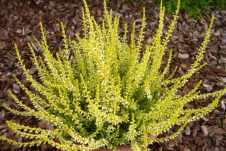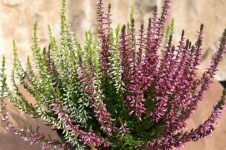Heather - planting and care in the open ground of this herbaceous crop is not difficult. Unpretentious plant is often used in landscaping. It is well suited for distinguishing between zones with different style decisions and purposes, it looks great against conifers and looks great when making tracks.
Material Content:
Plant description
Common heather - many legends and traditions are associated with this plant. In the struggle for existence in our difficult world, he won the right to grow freely in the swamps, forests, burial ground. It occupies a wide forest, right up to the tundra, area of the European continent. It occurs in North Africa and Asia, along the coast of the Atlantic Ocean of North America and in Greenland. This plant conquered even the Azores. The famous Scottish heathlands - harsh and rocky hills covered with a continuous carpet of fragrant pink flowers - inspired Robert Lewis Stevenson to create his famous ballad Heather Honey.
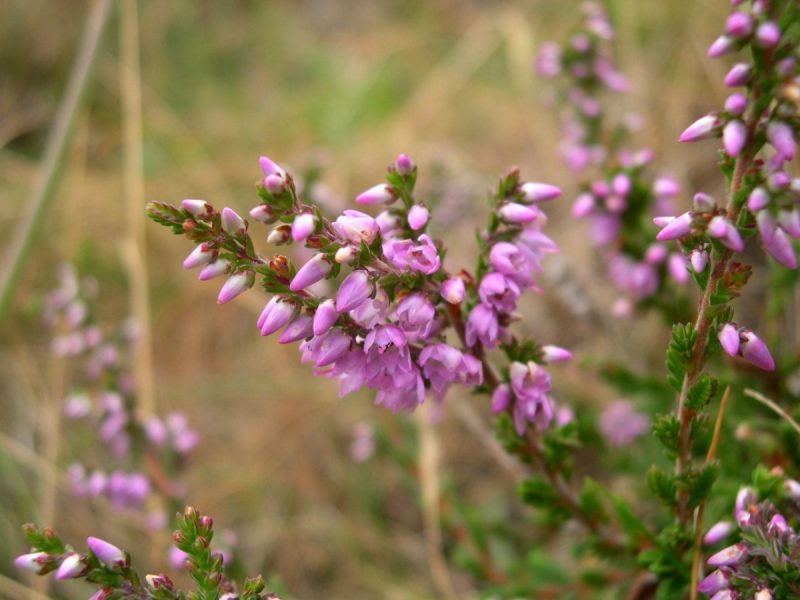
Heather is a wonderful honey plant. The healing power of products based on heather nectar and pollen is known throughout the world. Since it is one of the most powerful natural remedies for combating a number of diseases.
Today, experts count about five hundred varieties of heather. This is an evergreen shrub with creeping shoots. Their height can reach seventy centimeters long. He has interesting leaves - trihedral, as if wrapped in a tube. On each branch there are many small flowers, like bells, collected in inflorescences.They can be colored, depending on the variety, in lilac-lilac, pink. Heather looks especially beautiful after the first frost. At this moment, its stems and leaves change, become bright maroon.
Heather flowering usually begins in the second half of summer.
Choosing a place and seedlings for planting
The heather plant loves bright, open spaces and light, barely noticeable, partial shade. You need to choose a place for it carefully, because it does not like transplants, it does not take root well in a new area.
It should be noted that heather does not like strong winds. Therefore, it should be planted in a free area, sheltered by the wall of the house or a fence from the prevailing winds in the area.
Soil suitable wet peat. Some varieties feel good on dry sandy soil. Lime soil is strictly contraindicated. After all, its acidity for heather is essential, the pH is above five.
Artificial conditions can also be created for this plant by forming the soil of a mixture of peat with sand and compost of the bark of coniferous trees. In this case, it is better to add sour red peat to the mixture, rather than dark, grassroots.
Heather planting time is spring or autumn. The end of April-beginning of May or the end of September-beginning of October.
Landing heather in the open ground
On a suitable site they dig holes up to thirty (plus or minus five) centimeters deep.
One square meter is distributed among ten seedlings. Clay soil requires drainage.
At the bottom of each hole, a layer of ten centimeters must be laid drainage, consisting of pebbles, small fragments of bricks, in extreme cases, sand is suitable.

For top dressing, thirty grams of nitrophos or horn flour are added to the wells.
The plant should not be deepened, the neck of the root is left on a par with the surface of the soil. Then the entire surface of the soil where heather is planted is covered with mulch. Peat is suitable for this purpose.
Important Care Tips
Growing heather is not a very difficult job. For good health and successful development of this plant, it is periodically necessary to carry out three of the most important actions:
- Watering. Heather loves constantly moistened soil, moreover, the water should be slightly acidified. Since the roots of heather grow in breadth, not in depth. Watering once every ten days, immediately loosening the soil under the plant to a depth of ten centimeters. To keep moisture as long as possible, the root zone is covered with mulch. In drought, heather must be sprayed with water every night.
- Top dressing. Every year, in the spring, mineral fertilizers should be applied up to thirty grams per square meter in dry granules. In this case, it is necessary to proceed carefully, since having hit the surface of the leaf or touching the stem, the mineral fertilizer can cause a burn. Dip fertilizer into the mulch a little and pour it on top.
- Pruning. It is produced in the spring and only on plants that have already spent three years in open ground. Only half or two-thirds of the inflorescences are harvested. Trimming will be a good addition to the mulch. Https: //www.youtube.com/watch? V = tctr1O-1FOY
How to breed heather

Heather is propagated in four ways:
- The seeds. Heather has tiny seeds, they appear in small seed boxes. It is better to sow them in room conditions on the moistened earth in flower pots. Soil consists of white sand mixed with peat. Seedlings are grown under glass for a month, maintaining a temperature of about twenty degrees. From time to time they raise the glass to ventilate the seedlings. In summer, pots with young plants are taken out into the air and actively watered. In winter, stored in a greenhouse. Planting seedlings is possible only two years after sowing.
- Layering. The heather flower can reproduce itself in this way. Old shoots lie on the ground, under favorable conditions, sprout roots. Layings are also made artificially.You should bend the bottom shoot to the soil and dig it a little. And top with a layer of peat, ten millimeters thick. After a year, you can separate the layers with roots and transplant to a new site.
- Cuttings. When summer is drawing to a close, in August it is time to harvest heather cuttings. Cut off the tops of the best branches with flowers. They should be planted in peat pots, water and put in a place where the temperature will not exceed 18 degrees. Seedlings are fed once a couple of months, using a urea solution. In the spring they are planted in open ground.
- Rhizome division - The easiest and least time-consuming heather propagation method. The right time for such an event comes at the end of summer. For reproduction, you should choose a healthy bush, mature age. It is completely torn out, exposing the root system. At the same time, they try not to shake the soil from the roots. Then the whole bush is divided into several equal parts, cutting the roots. Old stems are cut, leaving only young shoots. In this case, all media are treated with coal. Then they plant each separated part in its own fossa.
Protection against diseases and pests
Most often heather is prone to the following diseases:
- Mixed chlorosis - It looks like yellow spots on the leaves, which subsequently dry up and fall away. The cause of the disease is unsuitable soil. Most often, this is an insufficient content of trace elements - magnesium, nitrogen, iron. Sometimes chlorosis causes a long not loosened, compacted soil, especially its upper layers. In addition, excessive watering leads to the fact that moisture stagnates. Therefore, the treatment in this case is simple - fertilizing the plant with mineral fertilizers in the complex, caring for the soil.
- Lamellar necrosis - the color of the leaf changes, its front side turns brown, the vein dies. The main reason is a sharp change in temperature, cold, wind. Saline soil, low water, lack of trace elements.
- Gray rot - In early spring, a gray coating appears on the leaves and shoots, the green mass is gradually dying. This is due to excess moisture in the soil and air. Often, heather was improperly prepared for winter, poorly sheltered. This disease is treated with the help of the preparations Fundazol and Topaz, by spraying with a solution of copper sulfate once a week for a month.
The healing properties of the plant
Traditional healers use heather or Calluna vulgaris (Latin name) as a medicinal plant.
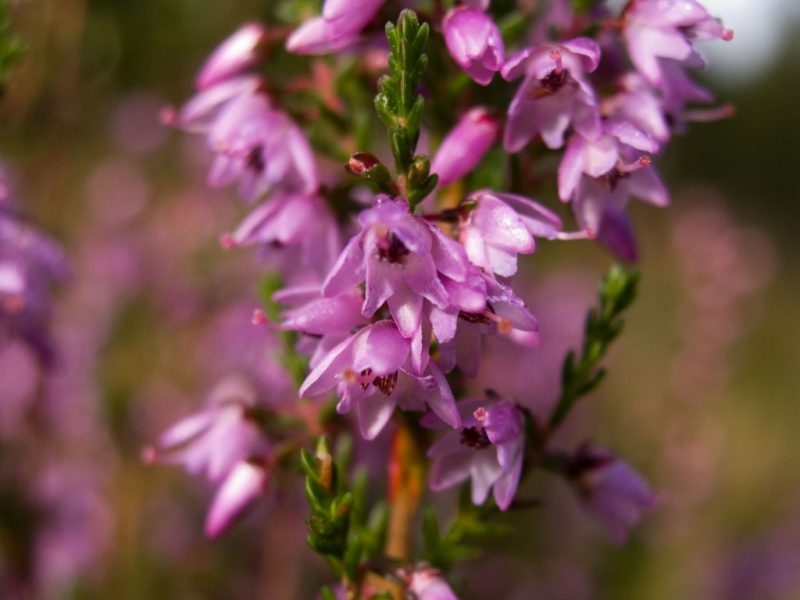
With the help of decoctions and infusions, the following diseases are treated:
- Kidney disease - cystitis, pyelitis, urethritis;
- Infectious - dysentery, enterocolitis, tuberculosis, tonsillitis;
- Gastric - gastritis, high acidity;
- Liver - cholecystitis;
- Cardiovascular - atherosclerosis;
- Diseases of the musculoskeletal system - rheumatism, gout, sciatica;
- Skin diseases - burns, wounds, eczema, problems with poor hair growth associated with the condition of the scalp;
- Diseases of the nervous system - as a natural sedative, sleeping pills;
Heather contains trace elements in flowers and stems - phosphorus, calcium, sodium and potassium. The plant also contains beneficial organic acids and flavonoids.
It has the following properties:
- Antibacterial;
- Heals wounds;
- Relieves inflammation;
- Promotes expectoration;
- Increases perspiration;
- Strong diuretic;
- It has a sedative effect;
Decoctions of the plant are taken orally for diseases associated with the gastrointestinal tract, liver, and cardiovascular system. During a sore throat, this broth gargles. Shredded dry powder is used for skin diseases. Relieve the condition with tuberculosis with the help of alcohol infusion from heather. To help with diseases of the musculoskeletal system, take a bath with a decoction.




